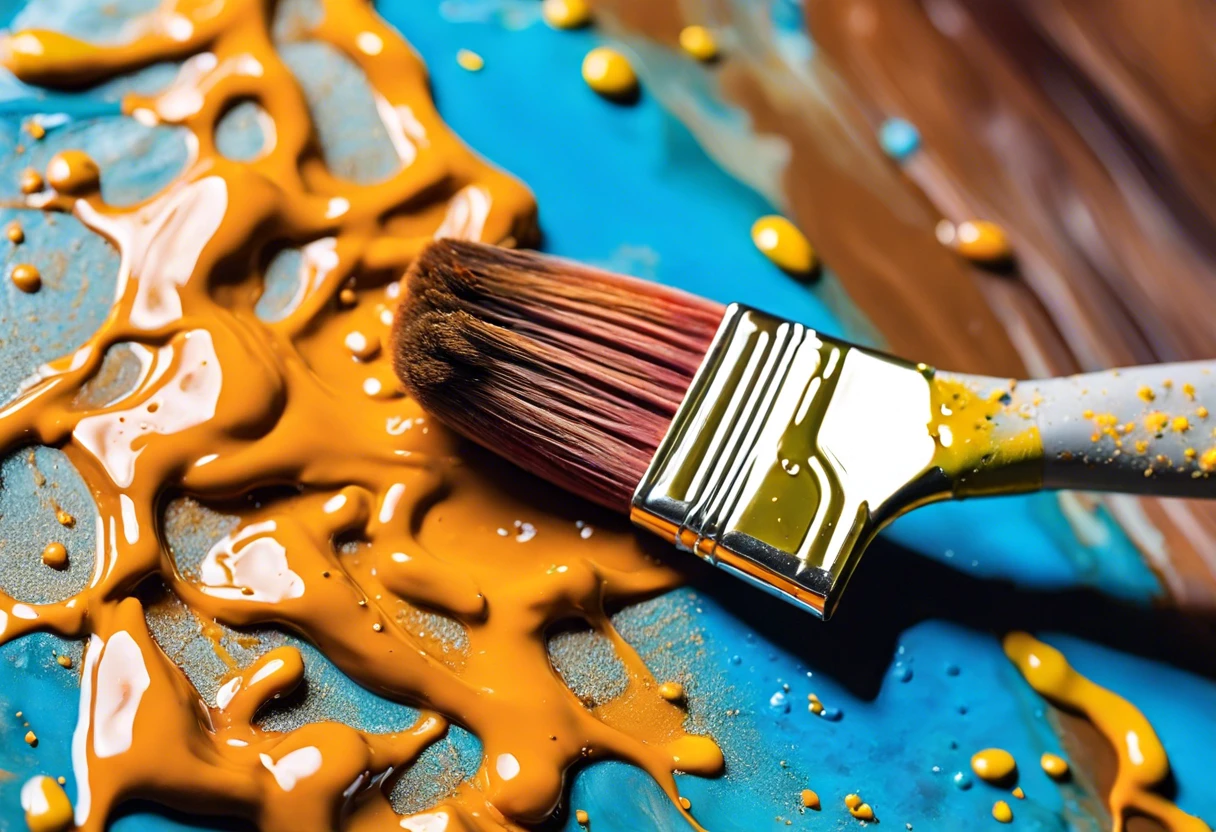How to Clean Dried Paint Brushes Acrylic?
Published on: March 6, 2025 | Last Updated: January 7, 2025
Written By: Alisha Winters
Paint brushes are the magical tools that help you splash colors on a canvas. They’re like little wands that artists use to create beautiful pictures!
Knowing how to clean dried paint brushes acrylic is super important. I’ve had brushes that looked like they’d been through a paint war, and cleaning them properly saved me money and kept my art flow going.
In this article, you’ll learn the essential preparations before cleaning, a step-by-step guide to revive your brushes, recommended palettes for your acrylics, types of brushes and their cleaning needs, common issues faced while cleaning brushes, and finishing touches for spotless tools. Let’s dive into how to clean old paint brushes and get them back to their vibrant selves!
Contents
- 1 How to Clean Dried Paint Brushes Acrylic?
- 2 What Are Paint Brushes?
- 3 Essential Preparations Before You Start Cleaning
- 4 Step-by-step Guide to Cleaning Dried Acrylic Paint Brushes
- 5 Types Of Paint Brushes and Their Cleaning Needs
- 6 Factors Affecting the Cleaning Process Of Dried Acrylic Paint Brushes
- 7 Softening Dried Acrylic Paint Techniques
- 8 Understanding Acrylic Paint Properties
- 9 Best Products for Brush Restoration
- 10 Common Issues Encountered When Cleaning Dried Acrylic Paint Brushes
- 11 Finishing Touches for Pristine Brushes
- 12 Best Practices for Maintaining Clean Acrylic Paint Brushes
- 13 When to Replace Your Acrylic Paint Brushes
- 14 DIY Brush Cleaning Solutions
- 15 Creative DIY Project Ideas With Cleaned Brushes
- 16 Frequently Asked Questions About Cleaning Dried Acrylic Paint Brushes
- 17 Conclusion
- 18 Useful Resources
How to Clean Dried Paint Brushes Acrylic?
To clean dried paint brushes acrylic, soak them in warm soapy water for 10-20 minutes. Gently scrub the bristles with your fingers or a comb to remove paint. Rinse thoroughly and reshape before letting them dry. Repeat if necessary. If you’re working with acrylic paints on different surfaces like shoes, you might want to explore painting techniques for footwear.
What Are Paint Brushes?
Paint brushes are essential tools for artists, typically made of bristles and a handle. The bristles, ranging from 0.5 cm to 6 cm (0.2″ To 2.5″) wide, come from various materials like synthetic fibers or natural hair, each affecting paint application and texture. If you’re considering painting walls in your living space, you might want to explore painting apartment walls effectively.
Now, let’s dive into cleaning dried paint brushes, especially for acrylics. I’ve battled hardened bristles, trying to revive old brushes I thought were useless.
I once relied on a trusty brush for detailed work, but when it got caked with acrylic paint, I learned how vital proper maintenance is. It might seem daunting to clean dried acrylic paint brushes, but nothing beats a little soap and patience to reclaim my trusted tools. When you need specific techniques for preserving your painting equipment, professional methods can make all the difference.
Essential Preparations Before You Start Cleaning
What do you need to prepare for cleaning dried paint brushes with acrylic?
- Clean Water: You’ll need clean water, like bottled or tap water, for rinsing the brushes thoroughly and removing paint residue.
- Brush Soap: Get high-quality brush soap, such as Master’s Brush Cleaner. It breaks down dried acrylic paint and preserves bristle quality.
- Paper Towels: Keep an ample supply of paper towels nearby. They’re essential for wiping the brushes during the process.
- Container: Use a glass or plastic jar, like a mason jar, to hold water while soaking brushes. This keeps the brushes upright and the water clean.
You should now have a good understanding of vital preparations before cleaning your brushes. In the next part, we’ll discuss a cleaning guide.
Also See: Can You Gesso Over Oil Paint? Discover the Secrets!

Step-by-step Guide to Cleaning Dried Acrylic Paint Brushes
Here are the steps to clean acrylic paint off brushes and make them reusable.
-
Soak the Brushes
Fill a bowl or sink with warm water, about 38-40°C (100-104°F). Submerge the bristles completely to soften the dried acrylic paint.
Soak the brushes for 10-15 minutes to loosen the paint for easier cleaning.
-
Gently Remove Dried Paint
After soaking, use a brush comb or an old toothbrush to gently dislodge any visible paint. Avoid aggressive scrubbing, as it can damage the bristles.
Work from the ferrule (The Metal Part) to the tip, refreshing the water as needed. Gentle techniques yield the best results without ruining your tools!
-
Wash With Soap and Water
Squeeze a small amount of gentle soap into your palm or directly onto the bristles. Biodegradable soap won’t harm your brushes or the environment.
Use your fingers to work the soap into the bristles, rinsing under lukewarm water periodically. This process may take about 2-3 minutes, depending on how much paint you have.
-
Rinse and Reshape
Rinse your brush thoroughly under running water until it runs clear. Ensure no soap or paint remains; otherwise, it may crumble when dry.
To reshape, gently squeeze the bristles and form them back into their original shape. Hold the brush firmly but don’t pull—I’ve ruined brushes this way! Let them dry flat or hanging to avoid water pooling at the ferrule. If you’re curious about alternative paint applications like face painting, acrylic paint safety matters.
So far we covered a step-by-step approach for cleaning dried acrylic paint brushes. Let’s look at the different paint brush types and their cleaning requirements next.
Types Of Paint Brushes and Their Cleaning Needs
Let’s explore different types of paint brushes: Flat, Round, Filbert, and Fan brushes.
-
Flat Brush
Flat brushes are ideal for bold strokes and large areas. To clean dried acrylic paint, soak them in warm soapy water for about 10-15 minutes.
-
Round Brush
Round brushes are great for detail work and precision painting. To clean old paint, use a brush comb and gentle soap, rinsing thoroughly until clean.
-
Filbert Brush
Filbert brushes combine features of both flat and round brushes. To remove dried paint from the bristles, use rubbing alcohol and a gentle touch.
-
Fan Brush
Fan brushes are perfect for creating texture and blending. To clean dried acrylic paint, soak them in a solution of dishwashing liquid and warm water for about 20 minutes.
Having worked in the field for a while, I really prefer the Round Brush. Its versatility is unmatched, and cleaning it with soap and a comb keeps it in top shape for detailed work!
We’ve wrapped up the various paint brush types and their cleaning requirements here. Let us turn our attention to factors influencing the cleaning process of dried acrylic paint brushes.
Factors Affecting the Cleaning Process Of Dried Acrylic Paint Brushes
What factors influence the cleaning of dried acrylic paint brushes?
-
Type of Paint: The acrylic paint’s composition determines how stubborn it is to remove.
-
Cleaning Solution: Different solvents can affect the efficiency of restoring the bristles.
-
Elapsed Time: The longer paint sits, the harder it becomes to clean the brush.
-
Brush Material: Natural and synthetic bristles each react differently to cleaning methods.
We covered the elements influencing the cleaning of dried acrylic paint brushes. We will now cover methods for softening dried paint.

Softening Dried Acrylic Paint Techniques
Let’s explore various methods that help soften and loosen that stubborn dried paint.
- Warm Soapy Water: Soak your brushes in warm, soapy water (about 38-40°C or 100-104°F) for 15-20 minutes. The heat helps break down the paint.
- Vinegar Solution: Mix equal parts of vinegar and water. Soak the brushes for about 10-15 minutes. Vinegar is a natural solvent that works wonders!
- Fabric Softener Trick: Use a mixture of fabric softener and water (one part softener to two parts water). This can soften bristles while loosening paint. Soak for 15 minutes.
Understanding Acrylic Paint Properties
Knowing the properties of acrylic paint can help you clean your brushes more effectively.
| Property | Description | Cleaning Implication |
|---|---|---|
| Water-Soluble | Acrylic paint mixes with water when wet. | Must act quickly! Once dry, it’s not easily removable with water. |
| Fast-Drying | Dries within minutes. | Immediate cleaning post-use is crucial to avoid hardening. |
| Flexible Finish | Once cured, it turns flexible, making it harder to remove. | Embeds into bristles if not cleaned promptly—leading to damage. |
Best Products for Brush Restoration
Check out some effective products for restoring your brushes!
- Master’s Brush Cleaner: Excellent for removing all types of acrylic paint without damaging bristles.
- Winsor & Newton Brush Cleaner: Specially designed for acrylics; it’s water-based and effective.
- Natural Soap Remedies: Bar soaps containing natural oils are gentle and clean well, maintaining the brush quality.
Common Issues Encountered When Cleaning Dried Acrylic Paint Brushes
My friend once tackled cleaning dried acrylic paint brushes, but she faced a real mess. The stubborn paint just wouldn’t budge no matter what she tried.
To fix this, soak the bristles in warm water (Around 38°C or 100°F) and dish soap for about 15 minutes. Gently work the paint out using a brush comb if needed. Super simple, right?
Finishing Touches for Pristine Brushes
After cleaning your paint brushes, reshape the bristles gently. Soak the brushes in a mixture of warm soapy water, like OxiClean (About 37°C / 100°F), for 10 minutes.
Inspect the bristles for loose hairs or split ends. Use a magnifying glass to check at least 2 inches (5 Cm) along the tips for defects caused by dried paint.
If you’re experienced, try using a fine-toothed comb designed for brushes. This helps untangle stubborn bristles without damaging the fibers, ensuring precision for your painting media.
Best Practices for Maintaining Clean Acrylic Paint Brushes
Once you’ve cleaned your brushes, keeping them in top shape can save time and effort later!
- Daily Rinsing: After each use, rinse your brushes immediately with warm water to prevent paint from drying.
- Gentle Storage: Store brushes upright in a container or flat in a drawer, ensuring the bristles aren’t bent or damaged.
- Regular Conditioning: Use brush conditioner or soap designed for artists every few uses to maintain bristle softness.
When to Replace Your Acrylic Paint Brushes
Not every brush can be saved. Here’s when you should consider getting new ones.
- Worn Bristles: If bristles are frayed or split beyond repair, it’s time to replace them.
- Loss of Shape: Brushes that can’t hold their shape after cleaning won’t perform well.
- Excessive Paint Build-Up: When paint hardens too deep and cleaning fails, think about a fresh start.
DIY Brush Cleaning Solutions
Looking for some homemade options? Here’s a rundown of effective cleaning solutions!
| Solution Type | Ingredients | Effectiveness |
|---|---|---|
| Vinegar & Water | 1 part vinegar to 1 part water | Good for softening and loosening paint |
| Dish Soap & Olive Oil | 2 parts soap to 1 part olive oil | Great for conditioning bristles while cleaning |
| Rubbing Alcohol | Isopropyl Alcohol (70% or higher) | Effective for stubborn dried paint |
Also See: Can You Use PVA Primer on Painted Walls? Learn More!
Creative DIY Project Ideas With Cleaned Brushes
Got some cleaned paint brushes lying around? Let’s transform them into stunning wall art or funky garden markers!
For wall art, simply arrange your brushes like a colorful little painting! It might cost you around $10-15 for a nice frame and take just an hour. Want to mark your herbs? Grab some soil and plant those cleaned brushes in pots, labeling them with the brush handles for about $5 in materials and 30 minutes of your time. If you’re feeling creative, you might even want to explore painting techniques and tips.
If you’re wondering how to clean dried paint brushes acrylic, don’t just toss ’em! Try soaking them in a mix of warm water and a squirt of dish soap; you’ll be amazed at how they revive! Or, for a more hands-on method, make a gentle scrub with vinegar and water—works wonders from my experience! When working with acrylic paints, knowing proper brush care extends beyond cleaning to surface preparation, which can be crucial for painting unique surfaces like pumpkins.
Frequently Asked Questions About Cleaning Dried Acrylic Paint Brushes
What is the Best Solvent for Cleaning Dried Acrylic Paint?
To clean dried acrylic paint, the best solvent is typically rubbing alcohol or specialized brush cleaner. Rubbing alcohol (Isopropyl Alcohol) can penetrate and dissolve the paint, making it easier for you to revive your brushes.
Can I Use Water to Remove Dried Acrylic Paint?
You can’t effectively use water to remove dried acrylic paint. Acrylics are water-soluble when wet, but once dry, they become resistant and need stronger solvents to dissolve their bonds.
How Do I Prevent My Acrylic Brushes From Drying Out in the Future?
To prevent acrylic brushes from drying out, always clean them immediately after use. Leaving paint on can lead to hard bristles and shortens the brush life significantly, sometimes even irreparably if left for just a few hours. If you’re wondering about broader applications of acrylic paint, you might want to explore painting techniques for walls.
Is It Safe to Soak Brushes for Too Long?
No, it isn’t safe to soak brushes for too long. Excessive soaking can damage the bristles or loosen the ferrule, affecting your brush’s performance over time.
Should I Throw Away Brushes That Have Dried Acrylic Paint?
Don’t rush to throw away brushes with dried acrylic paint! You can often restore them using proper cleaning methods. A good solvent might save those brushes you’ve considered replacing!
How Can I Tell if My Brush is Ruined?
Your brush might be ruined if the bristles are frazzled or elegantly clumping. Also, a brush that won’t retain its shape, even after thorough cleaning, typically indicates it’s past its prime.
Can I Reuse My Solvents?
Yes, you can reuse your solvents, but be cautious. Impurities can build up, reducing their effectiveness. Strain them through a coffee filter to help kind of refresh your cleaner.
Conclusion
We’ve reached the end, and I appreciate you sticking around. We covered essential preparations like water and soap, a step-by-step guide, common issues like bristle damage, finishing touches for pristine brushes, and even DIY project ideas to give those brushes new life.
To clean dried paint brushes acrylic, simply soak the bristles in warm water, gently scrub with mild soap, and rinse thoroughly. I hope these clean-up tips prove valuable to you in restoring your brushes to their former glory.
For more information and resources, be sure to check out our homepage: Paint Answers for all the helpful articles you need!
Useful Resources
- Edwards, B. (2012). Drawing on the Right Side of the Brain. New York, NY: TarcherPerigee.
- How to get dried acrylic paint out of brushes – Quora
- Save Your Dried Acrylic Paint Brushes – YouTube
Experienced interior designer with 15+ years in transforming spaces, blending artistry with expertise in color and design. Rhode Island School of Design graduate, specializing in restorations and modern makeovers.
Cleaning, Topics




